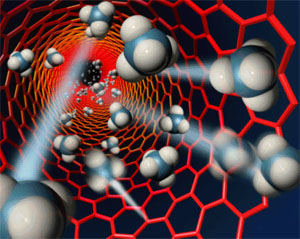Scientists solve problem of building carbon nanotubes with right structure
 Washington, September 21 : A pair of Case Western Reserve University researchers has come out with a method that solves the problem of building carbon nanotubes with the right structure.
Washington, September 21 : A pair of Case Western Reserve University researchers has come out with a method that solves the problem of building carbon nanotubes with the right structure.
The method has been developed by R. Mohan Sankaran, an assistant professor of chemical engineering at the Case School of Engineering, and Wei Hung Chiang, who received his doctorate degree in chemical engineering in May.
Single walled carbon nanotubes, made of a cheap and abundant material, have so much potential because their function changes when their atomic level structure, referred to as chirality, changes.
But for all their promise, building tubes with the right structure has proven a challenge.
Sankaran and Chiang mixed metals commonly used to grow nanotubes and found that the composition of the catalyst can control the chirality.
"We have established a link between the structure of a catalyst and the chirality of carbon nanotubes," Sankaran said.
"Change the catalyst structure by varying its composition, and you can begin to control the chirality of the nanotubes and their electrical and optical properties," he added.
The chirality of a single walled carbon nanotube describes how a lattice of carbon atoms is rolled into a tube.
The rolling can occur at different angles, producing different structures that exhibit very different properties.
Nanotubes are normally grown in bulk mixtures.
When using a nickel catalyst, typically one-third of those grown are metallic and could be used like metal wires to conduct electricity.
About two-thirds are semiconducting nanotubes, which could be used as transistors, Chiang explained.
But, separating them according to properties, "is costly and can damage the nanotubes," he said
Chiang and Sankaran found that a mixed iron and nickel catalyst could change the outcome.
Of the compositions tested, a catalyst of 27 percent nickel and 73 percent iron produced the most dramatic result: the vast majority of the nanotubes were semiconducting.
They are now working on assessing the purity and integrating the nanotubes into thin film transistors.
The researchers said that their findings open the door to experimenting with other elements as catalysts and different combinations, which may produce near-pure nanotubes with desired properties. (ANI)
